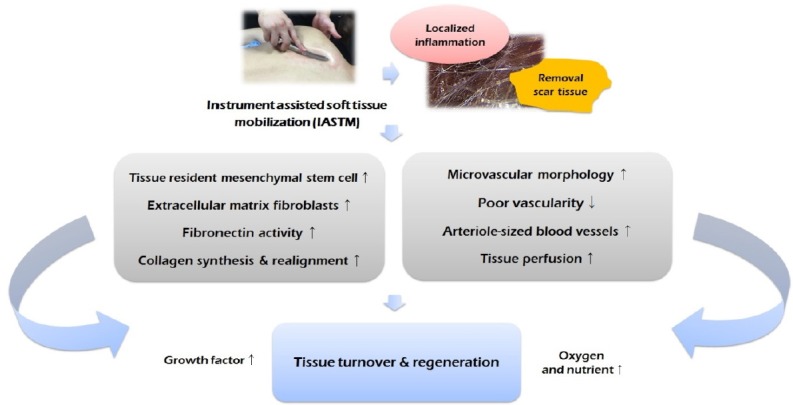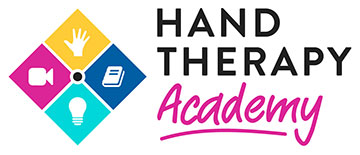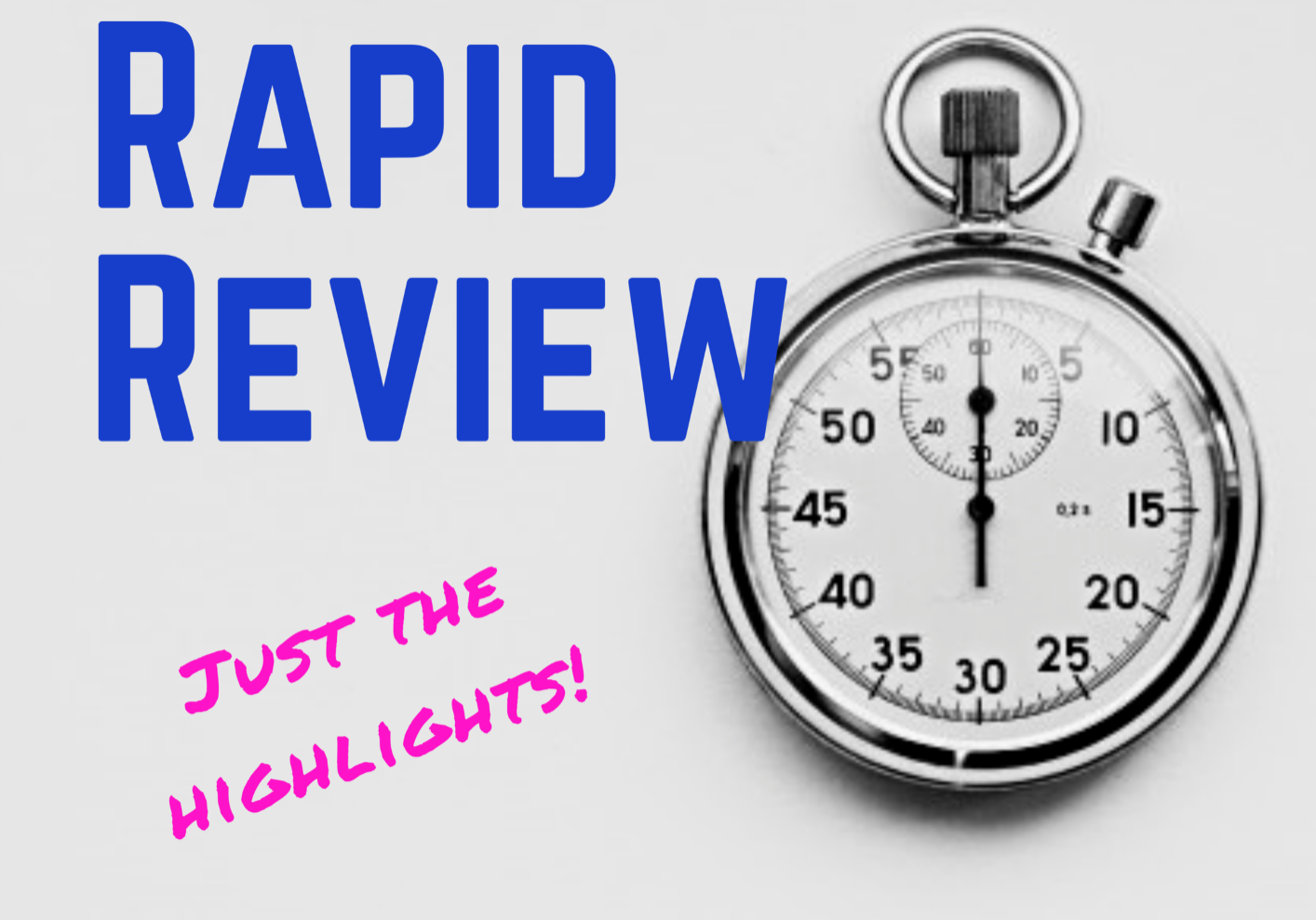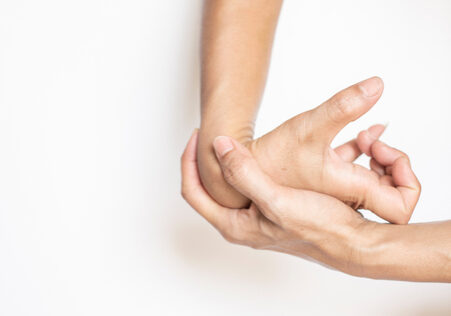- Citation
- Kim, J., Sung, D. J., Lee, J. (2017). Therapeutic effectiveness of instrument-assisted soft tissue mobilization for soft tissue injury: Mechanisms and practical application. Journal of Exercise Rehabilitation, 13(1). doi: https://doi.org/10.12965/jer.1732824.412
- The skinny
- IASTM is a relatively simple technique that uses the surface of an instrument to minimize the amount of pressure or force needed by the practitioner. Research has found that discomfort and fatigue levels reported by therapists were significantly lower compared to levels reported after using the metal end of a reflex hammer. IASTM has also shown to produce positive results in a shorter period of time when compared to manual friction massage (Hammer, 2008; Hayes et al., 2007).
- In the weeds – IASTM for scar tissue
- Removing scar tissues and promoting a return to prior level of function following soft tissue regeneration is the primary goal of IASTM. Black (2010), revealed that IASTM can break up scar tissue and help normalize the area surrounding the trauma or injury. IASTM can help promote vascular and capillary hemorrhage creating localized inflammation which begins the healing process. Removing scar tissue, releasing adhesions and increasing blood supply to the injured area was shown to increase movement of fibroblasts resulting in new collagen being laid down with properly aligned fibers.

- Bringing it home
- According to Sevier and Stegink-Jansen (2015), when IASTM was applied twice a week for 4 weeks in patients with lateral epicondylitis, their DASH scores decreased and grip strength increased at a higher rate compared to the control group who performed eccentric exercises alone.
- Howitt et al. (2006), found that treating trigger thumb with eight treatment sessions of IASTM over 4 weeks reduced pain.
- IASTM overall produced positive results when studied among upper extremity patients, with no negative side-effects, minimal training and low-cost for implementation.
Pros and Cons of IASTM
- Cons
- No standardized protocol across the studies included for implementing IASTM in treatment (IASTM protocol)
- Many of the studies referenced in this article included testing on animals
- This article focused primarily on using IASTM treatment with athletes not necessarily the general population
- The article included study results evaluating the entire body, it was not specific to the upper extremity only
- Pros
- There were several studies included in this article review, providing a broad variety of information
- Specific research evaluating IASTM for lateral epicondylitis and trigger thumb was included
References
Black, D. W. (2010). Treatment of knee arthrofibrosis and quadriceps insufficiency after patellar tendon repair: A case report including use of the graston technique. International Journal of Therapy Massage Bodywork, 3, 14-21.
Hammer, W. I. (2008). The effect of mechanical load on degenerated soft tissue. Journal of Bodywork and Movement Therapies, 12, 246-256.
Hayes, D., Loghmani M. T., Lubitz, R., & Moore, E. (2007). A comparison of 2 instrument-assisted soft tissue mobilization techniques: Effects on therapist discomfort/fatigue and treatment time. Journal of Orthopedic and Sports Physical Therapy, 37.
Howitt, S., Wong, J., & Zabukovec, S. (2006). The conservative treatment of Trigger thumb using Graston Techniques and Active Release Techniques. Journal of the Canadian Chiropractic Association, 50, 249-254.
Sevier, T. L., & Stegink-Jansen C. W. (2015). Astym treatment vs. eccentric exercise for lateral elbow tendinopathy: A randomized controlled clinical trial. Peer J. DOI:10.7717/peerj.967
5 Comments
Leave a Comment
More To Read
Pediatric & Adolescent Shoulder Instability
Lin, K.M, James, E.W., Spitze, E. & Fabricant, P.D. (2018). Pediatric and adolescent anterior shoulder instability: Clinical management of first-time dislocators. Current opinion in pediatrics, 30, 49-56. doi: 10.1097/MOP.0000000000000566. The Skinny: Shoulder instability for pediatric and adolescent patients is fairly common and is often complicated by a high re-dislocation rate. Shoulder instability typically occurs after…
Read MoreStretching After Stroke for Spasticity
Rapid Review By: Mikayla Murphy Kerr, L., Jewell, V. D., & Jensen, L. (2020). Stretching and splinting interventions for post stroke spasticity, hand function, and functional tasks: A systematic review. American Journal of Occupational Therapy, 74, 7405205050. https://doi.org/10.5014/ajot.2020.029454 The Skinny This study focused on the benefits of stretching the upper extremity to decrease spasticity, increase…
Read MoreTop 10 Powerful OT Specialty Certifications to Boost Your Career
Introduction to OT Specialty Certifications Occupational therapy (OT) continues to expand into dynamic new fields, and with that growth comes the need for specialization. Whether you’re a seasoned therapist or just starting out, pursuing OT specialty certifications can significantly boost your expertise and job opportunities. As healthcare becomes more complex in 2025, employers are increasingly…
Read MoreSign-up to Get Updates Straight to Your Inbox!
Sign up with us and we will send you regular blog posts on everything hand therapy, notices every time we upload new videos and tutorials, along with handout, protocols, and other useful information.






WONDERFUL Post.thanks for share..more wait .. …
thank you for reading
One the best blog I have ever read, great knowledge provides in this blog. Useful information.
thank you for kind comments
Digital Customer Engagement & Loyalty with Cellcard Cambodia Demonstrates Evolving Systems’ Expanded Presence in South East Asia